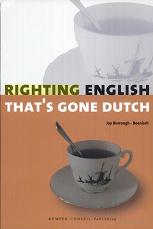
Righting English That's Gone Dutch
Joy Burrough - Boenisch
166 pages including index
published in 2004
I was going to start this review with a funny paragraph containing most or all of the errors Joy Burrough - Boenisch talks about in her book, but decided to be merciful and spare you the hilarity. If you do want examples, I'm sure I've made most of the mistakes she mentions at one time or another, either here or on my other blogs. Though I pride myself -- like everybody else in the Netherlands -- on my good command of English, both written and spoken, I still make the ocassional mistake, especially when tired or in a hurry. It's in those circumstances, when I'm not paying quite enough attention to what I'm writing and rely on instinct, that Dutch habits take over and mistakes are made, because I use the wrong translation, attempt to use Dutch rules of grammar, or do something else that works in Dutch but not as well or at all in English.
Which is what Righting English That's Gone Dutch is all about: those errors people with Dutch as their first language make in English when they go by assumptions carried over from the Dutch. It's intended for people who are perfectly comfortable writing in English, perhaps a little bit too comfortable, but who don't quite have the command of English a native speaker would have. As the author puts it, it's for people who write perfectly grammatical English, but with a Dutch accent: Dunglish. As such Righting English That's Gone Dutch isn't intended for people who only have a modest grasp of English, but for those of us who can write English perfectly well, apart from several niggling habits we've carried over from Dutch.
Righting English That's Gone Dutch is divided in some twentytwo short chapters, which each tackle a specific error made by Dunglish speakers. Some of these errors concern common spelling and grammer mistakes through confusion of Dutch rules with English, while others are more subtle, not quite mistakes but things a native speaker would never do. Talking about eggs and bacon instead of bacon and eggs, for example. Burrough - Boenisch even talks about paragraph placement, the differences between English and Dutch conventions of document layout and such.
The intended audience for all this advice is quite clearly people in business and academia who have to write a lot of formal documents in English. At times, this makes her advice less useful for other contexts, like say, writing a review for your booklog... It's all good and well to talk about the differences in paragraph placement between English and Dutch, but HTML forces you to use a different structure altogether anyway. And I don't think that anybody will stumble over w.r.t. as an abbreviation for "with regards to" on the web or elsewhere either, as was suggested here.
Righting English That's Gone Dutch is somewhat of a grabbag of common made errors, more of a reference guide than a book you'll read straight through. If you're a Dutch speaker who has to write a lot in Engish and you're a bit doubtful about your own abilities to do so without committing Dunglish, this is the book for you. Keep in mind though that it's business and university orientated and some of the advice given may not travel well outside these confines.
Read more about:
Joy Burrough - Boenisch,
Righting English That's Gone Dutch,
language,
book review